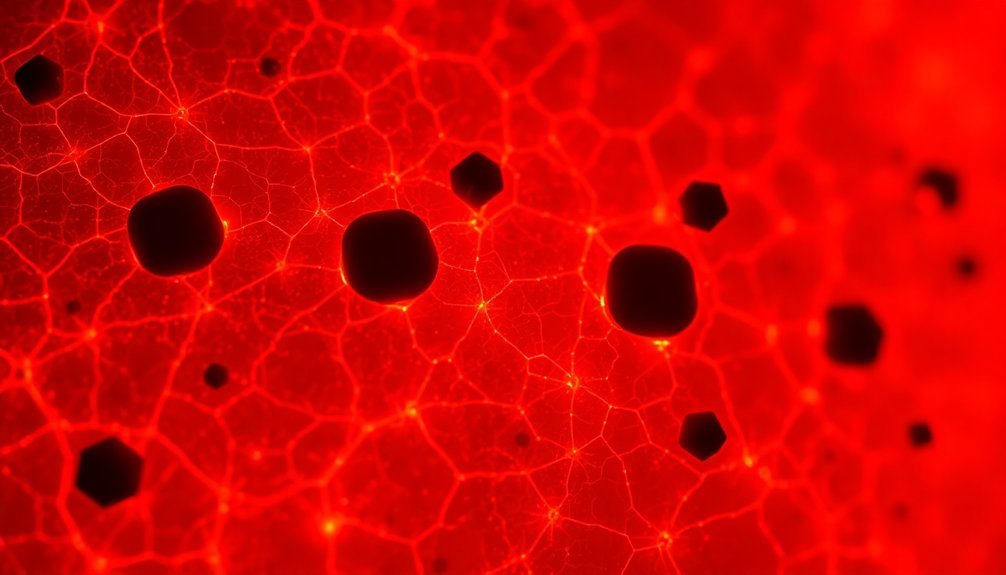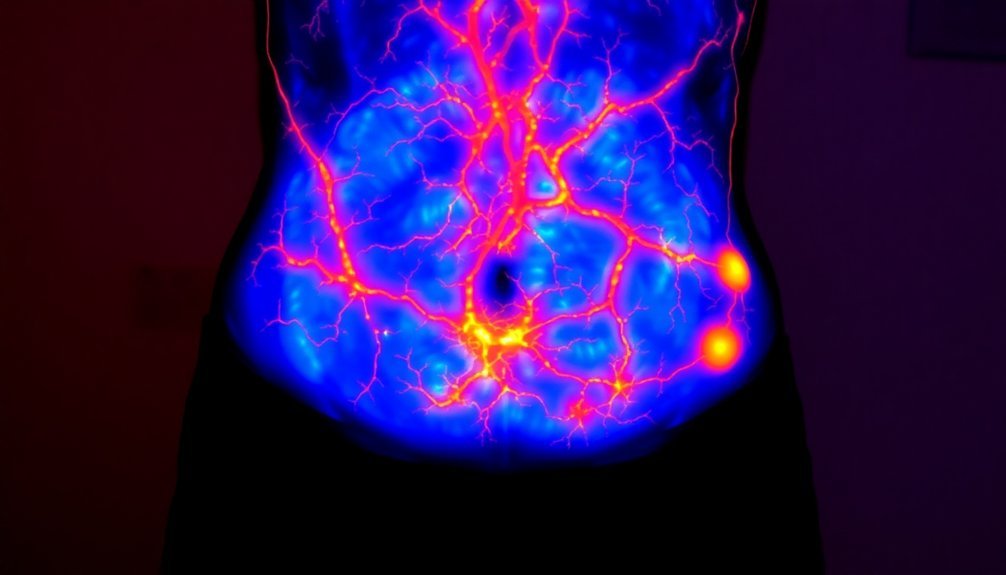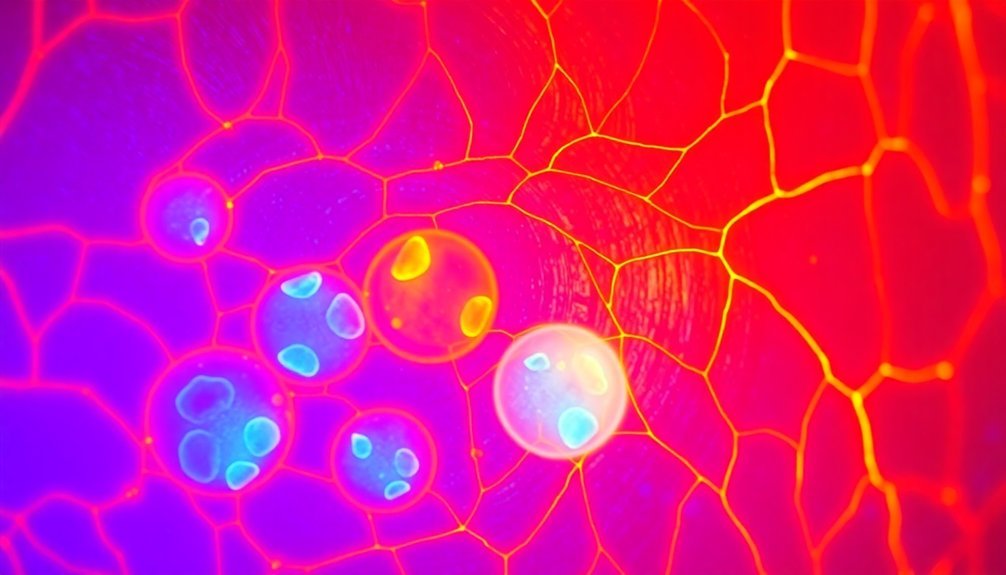Infrared light therapy targets fat cells through five key mechanisms you can understand. First, specific wavelengths penetrate your tissues to stimulate mitochondria, boosting ATP energy production. Second, the heat generated creates temporary pores in fat cells, releasing stored triglycerides. Third, enhanced blood flow and lymphatic drainage help remove broken-down fat. Fourth, the therapy activates non-shivering thermogenesis, increasing your calorie burn. Fifth, near-infrared wavelengths optimize tissue penetration for maximum effectiveness. The science behind these fat-breaking processes reveals an intricate system that works at the cellular level.
Red Light Chemical Process

Through red light therapy, your body undergoes a fascinating chemical transformation that targets stubborn fat cells. When specific wavelengths of red light (630-670 nm and 810-880 nm) penetrate your tissue, they trigger a process called photobiomodulation, which stimulates your mitochondria and boosts ATP production.
This increased cellular energy creates temporary pores in your fat cells' membranes, allowing stored triglycerides to leak into your bloodstream. The therapy utilizes low-powered LED lights that provide these benefits without generating harmful UV rays.
Once released, these triglycerides break down into free fatty acids and glycerol, which your body can use for energy. The process enhances your lymphatic drainage and improves blood circulation, helping reduce the appearance of cellulite.
You'll also benefit from increased collagen production, which leads to firmer skin.
Heat Activated Fat Release
Heat activation stands at the core of infrared-based fat reduction. When infrared light penetrates your tissues, it generates heat that triggers several physiological responses in your body. This penetrating warmth stimulates increased circulation and kickstarts your metabolism, setting the stage for enhanced fat breakdown. Similar to brown fat cells, your body's response to the heat involves non-shivering thermogenesis, promoting calorie burning.
You'll find that infrared therapy works through multiple mechanisms. As your body absorbs infrared light, it raises your core temperature, which boosts your metabolic rate and calorie burning.
The heat specifically targets fat cells, encouraging them to release fatty acids through a process called lipolysis. Your body then uses these released fatty acids as fuel, especially during physical activity.
To maximize fat breakdown, you'll need to maintain a caloric deficit while using infrared therapy. The process works best when you've got good blood flow, as this helps transport released fatty acids to where they'll be burned for energy.
While you can't solely rely on infrared therapy for spot reduction, combining it with targeted exercise can help address specific problem areas. Remember that various forms of infrared therapy exist, including saunas, lamps, and wraps, each designed to stimulate your body's natural fat-burning processes.
Mitochondrial Energy Production

Inside your cells, mitochondria serve as microscopic powerhouses that drive fat metabolism and energy production. These cellular engines convert nutrients into ATP through a sophisticated process called oxidative phosphorylation. Your mitochondria's inner membrane houses the electron transport chain, where high-energy electrons from NADH pass through five protein complexes, creating a proton gradient that powers ATP production. Each completed cycle through these complexes can yield over 30 ATP molecules.
| Process | Function | Impact |
|---|---|---|
| Electron Transport | Passes electrons between complexes | Creates proton gradient |
| Proton Pumping | Builds up protons across membrane | Powers ATP synthesis |
| ATP Synthesis | Converts gradient energy to ATP | Provides cellular energy |
| Oxygen Utilization | Completes electron transport chain | Enables fat metabolism |
When you're using infrared therapy for fat breakdown, you're directly influencing your mitochondrial function. Near-infrared light penetrates your cells and enhances ATP production by optimizing the electron transport chain. It also reduces inflammation and strengthens your cells' antioxidant defenses. Your mitochondria respond to this light therapy by increasing their energy output, which supports the breakdown of stored fat and improves overall cellular health.
Tissue Penetration Depth Analysis
Four key factors determine how effectively infrared light penetrates your body's tissues for fat breakdown.
First, wavelength plays a vital role – near-infrared light (NIR) between 730-840nm penetrates deepest, while red light only reaches 0.5 to 1mm into your tissue. You'll want to avoid wavelengths beyond 2000nm, as they'll only heat your skin's surface and could cause burning.
Your tissue structure substantially impacts light penetration. You'll get the best results in areas with thin epidermis and high fat-to-muscle ratios, like your thighs, upper arms, and chest.
Each tissue type absorbs and scatters light differently, affecting how deep the treatment can reach.
Light intensity matters tremendously – you'll need at least 100mW/cm², but 200mW/cm² or higher works better. It's imperative to maintain this intensity across a large treatment area for effective fat breakdown.
Consider devices that combine red and near-infrared wavelengths to target all depths of your hypodermis evenly.
These factors work together to create a therapeutic effect, stimulating your fat cells to release fatty acids and boosting your local circulation and metabolism through deep tissue heating.
Blood Flow Enhancement Mechanisms

Three key mechanisms drive blood flow enhancement during infrared therapy. Your body's response to infrared exposure triggers vasodilation, the release of nitric oxide, and thermal effects that work together to boost circulation.
When infrared light penetrates your tissues, it stimulates the production of nitric oxide, which helps your blood vessels expand and allows for increased blood flow.
This enhanced circulation delivers crucial benefits for fat breakdown:
- Your cells receive more oxygen and nutrients, accelerating metabolic processes
- Increased blood flow helps transport broken-down fatty acids away from fat cells
- Better circulation improves mitochondrial function, leading to more efficient fat oxidation
- Enhanced blood flow reduces inflammation that can contribute to fat storage
- The thermal effects raise your core temperature, further boosting metabolic rate
The combination of these mechanisms creates ideal conditions for fat breakdown. As your blood vessels dilate and circulation improves, you'll experience better nutrient delivery to tissues and more efficient removal of waste products.
Clinical studies show that this enhanced blood flow, particularly when combined with exercise, substantially improves fat loss outcomes compared to exercise alone.
Frequently Asked Questions
How Long Should Each Infrared Therapy Session Last for Optimal Fat Loss?
You'll get ideal fat loss results with 10-20 minute sessions, 2-3 times per week. Don't exceed these recommended durations, as overexposure won't increase effectiveness. Stay consistent with your treatment schedule for best outcomes.
Can Infrared Light Therapy Effectively Target Cellulite Reduction?
You'll get better results using infrared light therapy combined with other treatments like radiofrequency and massage. On its own, it's not highly effective for cellulite reduction, though it can enhance other treatment methods.
Is Infrared Light Therapy Safe During Pregnancy?
While non-heating infrared light therapy is generally considered safe during pregnancy, you'll want to avoid heating treatments. Always consult your healthcare provider first, as maintaining safe body temperature is essential for fetal development.
How Soon After Eating Should One Wait Before Infrared Treatment?
While there's no definitive research on exact timing, you'll want to wait 2-4 hours after eating before infrared treatment. This allows for initial digestion and may help optimize your body's response to the therapy.
Does Skin Color or Thickness Affect Infrared Light Therapy Results?
Yes, both skin color and thickness impact your results. You'll need higher energy doses with darker skin or thicker tissue, as these factors reduce light penetration and effectiveness of infrared light therapy treatments.
In Summary
You've now learned how infrared therapy works at a molecular level to break down fat cells. From the chemical reactions triggered by red light to the deep tissue penetration that activates mitochondria, you're equipped with the science behind this process. Whether you're using professional treatments or at-home devices, you'll get better results by understanding how heat, blood flow, and cellular energy work together in infrared fat reduction.





Leave a Reply